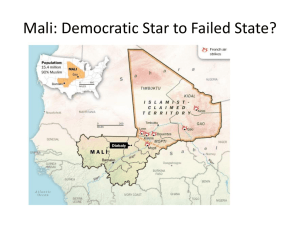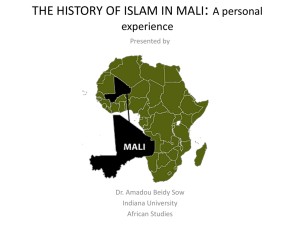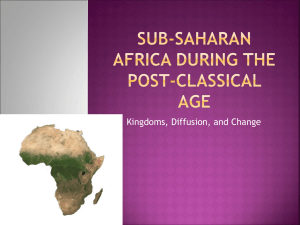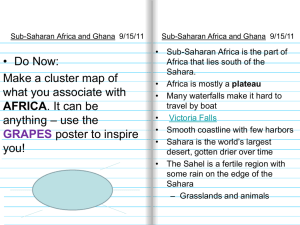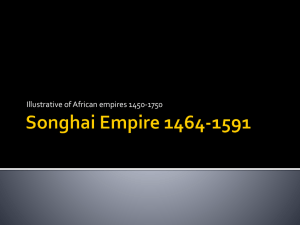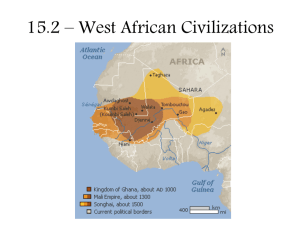LP- Trio Da Kali, Gr..
advertisement
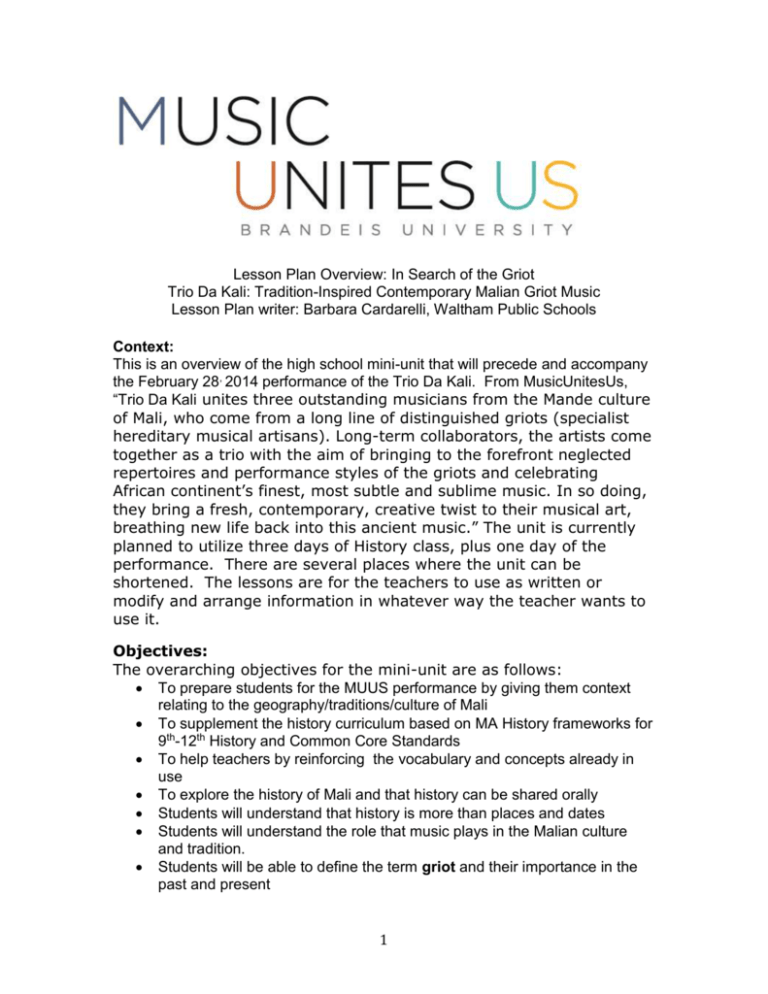
Lesson Plan Overview: In Search of the Griot Trio Da Kali: Tradition-Inspired Contemporary Malian Griot Music Lesson Plan writer: Barbara Cardarelli, Waltham Public Schools Context: This is an overview of the high school mini-unit that will precede and accompany the February 28, 2014 performance of the Trio Da Kali. From MusicUnitesUs, “Trio Da Kali unites three outstanding musicians from the Mande culture of Mali, who come from a long line of distinguished griots (specialist hereditary musical artisans). Long-term collaborators, the artists come together as a trio with the aim of bringing to the forefront neglected repertoires and performance styles of the griots and celebrating African continent’s finest, most subtle and sublime music. In so doing, they bring a fresh, contemporary, creative twist to their musical art, breathing new life back into this ancient music.” The unit is currently planned to utilize three days of History class, plus one day of the performance. There are several places where the unit can be shortened. The lessons are for the teachers to use as written or modify and arrange information in whatever way the teacher wants to use it. Objectives: The overarching objectives for the mini-unit are as follows: To prepare students for the MUUS performance by giving them context relating to the geography/traditions/culture of Mali To supplement the history curriculum based on MA History frameworks for 9th-12th History and Common Core Standards To help teachers by reinforcing the vocabulary and concepts already in use To explore the history of Mali and that history can be shared orally Students will understand that history is more than places and dates Students will understand the role that music plays in the Malian culture and tradition. Students will be able to define the term griot and their importance in the past and present 1 Daily objectives: Day 1- To give context to the performance by reviewing some of the geography of Mali. Students will be able to complete a map of Mali by labeling key places and physical features. Students will also interpret country facts to write about the present state of Mali. Students will understand who Sundiata is and how griots have told his story. They will understand the griot’s role in West African society and their oral tradition. Day 2- Students will read and interpret a primary source. What was the purpose of creating the Journal? What does the creator do to get her point across? Students will be able to apply analysis skills to a primary source. Through the primary source, students will gain an understanding of Malian traditions past and present. Day 3- Students will be able to view an online video and see the visiting artist teach her daughter the skills of the griot. Students will be introduced to the jembe and the kora, two other griot instruments all being learned by children, passed down in an oral tradition. Students will write 10 observations of the griots and their work. Day 4- Performance Assessments: Formative assessments are built into each lesson Standards: MA Curriculum Frameworks World History I Learning Standards WHI.18 Identify the locations and time periods of the empires of Ghana, Mali, and Songhai.(H, G) WHI.19 Describe important political and economic aspects of the African empires. (H, E) A. the economies of these empires (gold, salt, and slaves as commodities for trade by African kings) B. leaders such as Sundiata and Mansa Musa C. Timbuktu as a center of trade and learning WHII.15 Identify major developments of African history in the 19th and early 20th century. (H,E) WHII.11 Describe the causes of 19th century European imperialism. (H,E) Concepts and Skills, Grades 8-12 8. Interpret the past within its own historical context rather than in terms of present-day norms and values. (H, E, C) 11. Using historical maps, locate the boundaries of the major empires of world history at the height of their powers. (H, G) 2 Common Core CCSS.ELA-Literacy.RH.9-10.2 Determine the central ideas or information of a primary or secondary source; provide an accurate summary of how key events or ideas develop over the course of the text. CCSS.ELA-Literacy.RH.9-10.4 Determine the meaning of words and phrases as they are used in a text, including vocabulary describing political, social, or economic aspects of history/social science. CCSS.ELA-Literacy.RH.9-10.9 Compare and contrast treatments of the same topic in several primary and secondary sources. CCSS.ELA-Literacy.WHST.9-10.2b Develop the topic with well-chosen, relevant, and sufficient facts, extended definitions, concrete details, quotations, or other information and examples appropriate to the audience’s knowledge of the topic. CCSS.ELA-Literacy.WHST.9-10.7 Conduct short as well as more sustained research projects to answer a question (including a self-generated question) or solve a problem; narrow or broaden the inquiry when appropriate; synthesize multiple sources on the subject, demonstrating understanding of the subject under investigation. Lesson Plans: Day 1 Ask students about any pre-knowledge that they have about Mali. The ancient kingdoms were studied in 7th and 8th grade history classes. Mali, at one time, was a wealthy region. The ancient kingdoms of Ghana (9001100), Mali (1200-1450), and Songhai (1450-1590) became very wealthy and powerful from the gold and salt trade. European wares, gold, ivory, and enslaved peoples were also traded along the routes. Ideas, inventions, and religion were spread along the trade routes. Hand out worksheet with map of West Africa, current facts and paragraph to write. Students can use an atlas to complete the map. When students have completed the paragraph, ask volunteers to read their paragraph. Discussion: What if you had to read your account of Mali aloud? How would your audience respond? Are there a bunch of facts written? Would it be exciting and hold everyone’s interest so they would want to hear more about Mali? If anyone read their paragraph aloud, did it hold your interest? Think about oral presentations that you’ve heard and have made an impression on you? Has a friend ever related a story about an event at home or school? Have they included lots of detail and imagery? Have they used figurative language to make it intriguing? 3 Information: West Africa had no written language until the Muslim traders brought Arabic writing to this area. The villages relied on an oral historian called Griot or Jeli. The griot is a storyteller, entertainer, and historian. The history was not told in lecture form, but it was told to the villagers who were informally gathered around the campfire at the end of the day. Music accompanied the stories. One famous story was about Sundiata, a king of Mali. This story has become one of the world’s greastest epic of oral tradition of the Mande, or Manding people, who can trace their heritage to Sundiata. This boring version was taken from Hands on Culture of West Africa by Kate O’Halloran, “Mali: Griots and the Story of Sundiata.” Read to the class: “Sundiata was born in the early 1200’s in Mali. He was one of twelve brothers who were heirs to the throne of the kingdom of Kangaba. When Sumanguru, ruler of a neighboring state, overran the kingdom, he killed all Sundiata’s brothers. Sundiata was spared because he was frail and ill, unable to walk. Sumanguru thought he could not be a threat. However, Sundiata lived to grow strong, and eventually overthrew Sumanguru to become ruler of Mali. He died in 1255. “ Here is part of the story told by Djeli Mamakou Kouyate: (Jalis or Jeli means the same as griot) “Listen then, sons of Mali, children of the black people, listen to my word, for I am going to tell you of Sundiata, the father of the Bright Country, of the savanna land, the ancestor of those who draw the bow, the master of a hundred vanquished kings.” Ask the students if they can hear/feel the difference? The griot used descriptive language, and details, while the first story was very factual. Is it easier for you to remember facts for a test or lyrics to a song? Ask students to give examples of this. (If you want more information on this, see Sunjata, Gambian versions of the Mande epic by Bamba Suso and Banna Kanuteh, edited by Lucy Duran and Graham Furniss, with a new introduction and additional notes. London: Penguin Classic. l999.) Write the definitions of the vocabulary words Oral Tradition and Griot on the board for the students to write on their paper. Oral Tradition – tradition passed down by word of mouth (storytelling). Griot – a storyteller of Mali who uses oral tradition to pass down Mali’s history to future generations. 4 Assignment: Have students give an oral history about a topic in History that they are studying or have studied. They can write a factual paragraph, then a griot’s version, and then share their stories with the class. Day 2 Run off about 8 sets of the following Journal, depending on how many students you have. Judith Eissenberg is the director of MusicUnitesUs and recently visited Mali. She met with the trio that will be performing for the students. She had a chance to visit and experience Malian culture. Her journal, “Mali Journal: In Search of the Griot” is informational, inspirational, and insightful. The journal will be the primary source which the students will use to complete the template, “In Search of the Griot.” http://www.brandeis.edu/musicunitesus/residency/malijournal.html In a way, her journal is a story, full of imagery, implications, and inquiry. Once the students read it, they will understand the meaning of the word Griot. To complete the template, students will work in groups of 3 (teacher discretion). Students will give 2 pieces of evidence from the journal for each topic on the template. Evidence is a quote. Explanation is an analysis. Completed template will give the students a current view of Mali and the importance of its traditions. Discuss with the students Mali today and have them share their evidence with the class. Together, write a definition of griot. (Students will be adding to this definition after viewing the video. Day 3 Students will view the first 27 minutes of the online video: Growing into music: Da kali-the pledge to the art of the griot vol 1. This is a 2013 video filmed on location in Mali and Guinea and directed by Lucy Duran. Her biography, along with the trio’s, is found on the Brandeis MusicUnitesUs site and I attached a copy of it at the end of the lesson. The first 27 minutes introduces us to Hawa Kasse Mady, the visiting female griot, teaching her daughter, Rokia, to sing. We are introduced to the djembe and the kora, two other griot instruments, all being learned by children, passed down in an oral tradition. Run off the template, 10 Fascinating Fabulous Facts about Griots for each student Have students complete the template, 10 Fascinating Fabulous Facts about Griots At the end of the movie, have students add to the class definition of a griot. Ask the students about their search for the griot!! https://www.growingintomusic.co.uk/~electrj0/mali-and-guinea-music-of/filmsof-growing-into-music.html 5 Day 1 Geography and Current facts Geography 1. On the map of West Africa, locate and label the following: Countries: Mali, Algeria, Ghana, Niger, Mauritania, Burkina Faso, Guinea, Senegal, Gambia, Cote D’Ivoire, and Nigeria Cities: Bamako, Timbuktu, Gao, Taoudenni, and Djenne Physical Features and Bodies of Water: Sahara Desert, Sahel, Atlantic Ocean, Gulf of Guinea, and the Niger River 2. The shaded area represents the Kingdom of Mali (1240-1450). a. Which present countries were part of that kingdom? b. What inference can you make about Mali’s climate? Explain. c. For trade to flourish, what obstacle did the caravans have to cross? d. Why do you think this region was important in the development of West African civilization? 6 Current Facts Capital – Bamako Colonial independence from France-1960 Languages spoken- French, Bambara, many others Government – in transition after coup and insurgency % population under15 – 48% Literacy rate – male, 43% and female, 25% Life expectancy – male, 52 and female, 56 Per capita GDP – $1,100 (this figure represents the value in U.S. dollars of all goods and services produced within a country in one year divided by its population and is a common way to measure a nation’s wealth. The U.S. GDP per capita is $50,700.) Question: What European country colonized Mali before its independence in 1960? Explain. Assignment: Based on the current facts of Mali, write a short paragraph about the country of Mali today. _______________________________________________________ _______________________________________________________ _______________________________________________________ _______________________________________________________ _______________________________________________________ _______________________________________________________ _______________________________________________________ _______________________________________________________ _______________________________________________________ _______________________________________________________ _______________________________________________________ _______________________________________________________ _______________________________________________________ _______________________________________________________ _______________________________________________________ _______________________________________________________ _______________________________________________________ _______________________________________________________ _______________________________________________________ Vocabulary: Oral Tradition Griot - 7 In Search of the Griot Topic/Explantion Meaning of griot Evidence 1 Evidence 2 Physical surroundings Role of Griot at Weddings 8 Topic/Explanation Political problems in Mali Role of Women Music/Instruments 9 TEN FABULOUS FASCINATING FACTS ABOUT GRIOTS 1. 2. 3. 4. 5. 6. 7. 8. 9. 10. 10 Bios for Dr. Lucy Durán (ethnomusicologist and residency curator/speaker) and musicians of Trio Da Kali Trio Da Kali at Brandeis University: Feb. 26 – March 1, 2014 Trio Da Kali: Tradition-inspired Contemporary Malian Griot Music In partnership with the Aga Khan Music Initiative, MusicUnitesUS presents a weeklong residency with Trio Da Kali. Join the Brandeis community in a series of events: informal open classes, workshops, and performances with the visiting artists. Visiting residency curator and speaker, ethnomusicologist Lucy Durán will introduce and guide us through an exploration of a contemporary cultural expression with roots in the ancient tradition of musical story-telling and praise-singing. Dr. Lucy Durán BMus, MMus (London), PhD (London) SOAS, Dept. of Music: Lecturer in African Music, Centre for Migration and Diaspora Studies Lucy Durán (PhD SOAS) is a university lecturer specializing in West African music, and is based in the Music Department of the School of Oriental and African Studies, University of London. She has published widely: on Mali’s music, its women singers, and on the kora. She is also a broadcaster (she was the regular presenter of BBC Radio 3’s leading world music program World Routes from 20002013). Durán has a long professional involvement with the music industry, and has been at the forefront of the promotion and dissemination of Malian music for the past 25 years. Her special interest is in finding ways of creating a contemporary voice for Malian artists working within their own traditions. She is also a music producer, and has produced many Malian artists including Grammy awardwinning kora player Toumani Diabaté, and the highly acclaimed Malian ngoni player Bassekou Kouyaté. Two of her albums have received Grammy nominations. Having devoted much of her professional life to balancing her broadcasting, recording, and academic work, Durán argues for the need to forge better links and understanding between the media and academia. Her film project Growing into Music, sponsored by a major grant from the Arts and Humanities Research Council UK, explores through film the diverse methods of oral transmission of music across generations in Mali, Cuba, India, Venezuela and Azerbaijan. Within this project, she has filmed and directed two in-depth documentaries on Malian children learning music in griot families, which can be seen on the Growing into Music website www.growingintomusic.co.uk Durán is also privileged to be project advisor to the Aga Khan Music Initiative’s important work both in Mali and with Malian music internationally. TRIO DA KALI Fodé Lassana Diabaté 22-key balafon Hawa Kassé Mady Diabaté singer Mamadou Kouyaté bass ngoni Trio Da Kali unites three outstanding musicians from the Mande culture of Mali, who come from a long line of distinguished griots (specialist hereditary musical artisans). Long-term collaborators, the artists come together as a trio with the aim of bringing to the forefront neglected repertoires and performance styles of the griots and celebrating African continent’s finest, most subtle, and sublime music. In so doing, they bring a fresh, contemporary, creative twist to their musical art, breathing new life back into this ancient music. 11 An original combination of voice, bass ngoni, and balafon, the trio takes their name from one of the oldest songs in the griot repertoire, an acapella praise song that recalls the role of the griots as advisors to Mali’s pre-colonial rulers. “Da kali” means “to swear an oath” and represents the griots’ pledge to their art. Trio Da Kali present a performance that revolves around the soaring, rounded vibrato voice of Hawa Kasse Mady (compared by some to Mahalia Jackson), who performs the songs she grew up surrounded by in Kela, one of the most musical centres of the griot world. The programme includes dazzling solo balafon pieces by the group’s leader Lassana Diabaté on the 22key balafon. Few can match his lyricism and virtuosity, and the resonant sound of the rosewood keys of his balafon. Mamadou Kouyaté, the eldest son of ngoni maestro Bassekou Kouyaté, underpins the music with punchy bass lines on a large ngoni, West Africa’s oldest string instrument. Trio Da Kali and its connections with the West: The Trio comprises two generations of musicians from some of the most important and innovative musical families in the Mande world since independence. All have connections with various local musical initiatives that have dealt with western influences as a means of confronting the need to modernise. Hawa Kasse Mady Diabate grew up in Kela, a small village considered the heart of the jeli tradition, and was trained by her great-aunt, Sira Mory Diabate, Mali’s most celebrated female singer since independence. She also learnt from her father, Kasse Mady Diabate (one of Mali’s most treasured singers). He has been a major figure on the Malian music scene for four decades. He was recruited from his village into Mali’s popular dance band “Los Maravillas de Mali” when they returned to Mali after studying Cuban music for eight years in Havana. Because of Cultural Authenticity policies in the early 70s, they were renamed “National Badema” (National family). Kasse Mady, with his deep knowledge of Mande epic singing, was charged with bringing a more indigenous repertoire to the group. He has passed this heritage on to his daughter. Most recently, Hawa’s father featured in the Mali-Cuba collaboration, AfroCubism, which also included the musical director of Trio Da Kali - the balafon player, Lassana Diabate - as well as the Bassekou Kouyate, the ngoni virtuoso. Bassekou is the father of the youngest member of Trio Da Kali, the bass ngoni player Mamadou Kouyate. Hawa Kasse Mady has only just begun to perform outside Mali, as a result of the Aga Khan Music Initiative-sponsored collaboration with the Kronos Quartet. But locally, in Bamako where she lives, she is much demand at the lively wedding parties that take place in the street and are an important way for jelis to update and draw new audiences into their musical traditions Mamadou Koutaté is a member of his father’s band, Ngoniba, who were nominated for a Grammy in 2009 and with three successful albums, tour the world. In his early 20s, Mamadou plays with many of Mali’s top young musicians in Bamako, in hip-hop , reggae, and blues styles. This family has brought the ancient instrument, the ngoni, into the 21st century, reconnecting it with the banjo and with blues. Lassana Diabate is a virtuoso balafon player originally from Guinea who moved to Mali in his late teens in the early 90s. He has been at the cusp of musical innovation in Mali since then, working with Taj Mahal, Salif Keita, Toumani Diabate, Dee Dee Bridgwater, and many others. 12 Works Cited Websites wiki.coe.jmu.edu/K507/admin/download.html?attachid=110557 http://www.brandeis.edu/musicunitesus http://www.brandeis.edu/musicunitesus/residency/malijournal.html https://www.growingintomusic.co.uk/~electrj0/mali-and-guinea-music-of/films-of-growing-intomusic.html Map Kingdoms and Empires[edit] en.wikipedia.org Books Glencoe Geography: The World and Its People. New York, NY: Glencoe McGraw-Hill, 2002. Print. Junior Scholastic 14 Oct. 2013: n. pag. Web. O'Halloran, Kate. Hands-on Culture of West Africa. Portland, Me.: J. Weston Walch, 1997. Print. Suso, Bamba, and Banna Kanuteh. Sunjata, Gambian Versions of the Mande Epic. London: Penguin Classics, 1999. Print. 13


